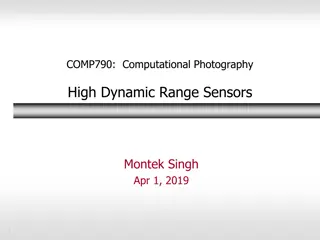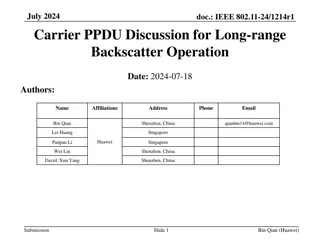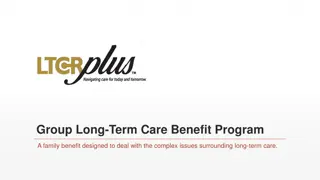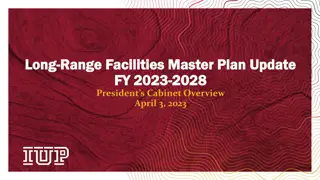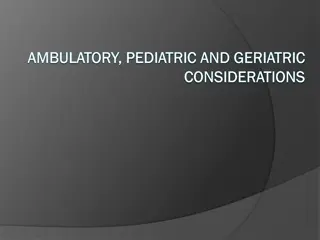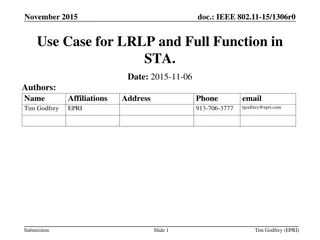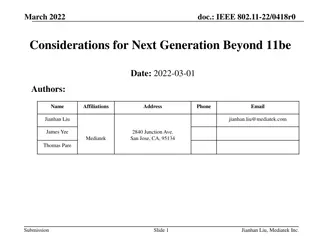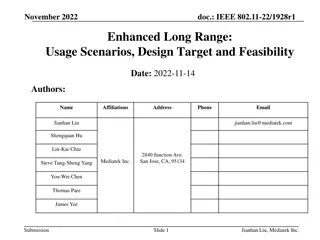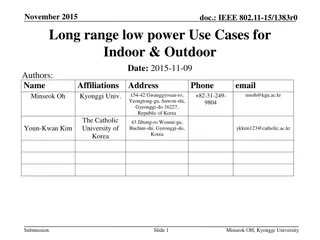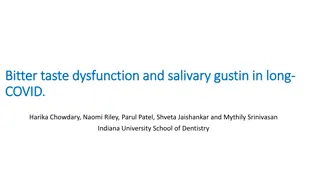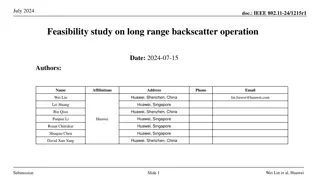
Considerations on Long Range Operations in IEEE 802.11-16/0683r0
Dive into the considerations and challenges of long-range operations in IEEE 802.11-16/0683r0, including link budget, coexistence, and use cases like tunnels and underground mines. Explore the implications of different channel types and path loss models on link budget analysis for improved connectivity.
Download Presentation

Please find below an Image/Link to download the presentation.
The content on the website is provided AS IS for your information and personal use only. It may not be sold, licensed, or shared on other websites without obtaining consent from the author. If you encounter any issues during the download, it is possible that the publisher has removed the file from their server.
You are allowed to download the files provided on this website for personal or commercial use, subject to the condition that they are used lawfully. All files are the property of their respective owners.
The content on the website is provided AS IS for your information and personal use only. It may not be sold, licensed, or shared on other websites without obtaining consent from the author.
E N D
Presentation Transcript
May 2016 doc.: IEEE 802.11-16/0683r0 Considerations on Long Range Date: 2016-05-16 Authors: Name Affiliation Address Email Ke Yao ZTE yao.ke5@zte.com.cn Xuelin Zhang ZTE Zhang.x_l@zte.com.cn Bo Sun ZTE sun.bo1@zte.com.cn Nan Li ZTE li.nan25@zte.com.cn Weimin Xing ZTE Xing.weimin@zte.com.cn Kaiying Lv ZTE lv.kaiying@zte.com.cn Submission Ke Yao, et, al. (ZTE) Slide 1
May 2016 doc.: IEEE 802.11-16/0683r0 Abstract LRLP approach and approach of coexistence for long range are expected to be the main topics for this meeting. We proposed some considerations regarding long range, including link budget, challenge and coexistence. We also proposed use cases of tunnel and underground mine. key differentiator, long range operation Submission Ke Yao, et, al. (ZTE) Slide 2
May 2016 doc.: IEEE 802.11-16/0683r0 Basic Link Budget Assumption and Analysis Next slide shows the link budget result based on the following assumptions: Path Loss Model and shadow fading [1] Note that shadow fading for 11n channel B and channel D is included in Path Loss model, but there is no shadow fading factor in Path Loss model for Umi NLOS/LOS. Using the values of required SINR in [2], we got very similar range results in meters. Narrow band (2 MHz) can bring 10 dB path loss margin compared with 20MHz, that means about double range of coverage in meters, or 2 more walls, or less than 1 floor. Submission Ke Yao, et, al. (ZTE) Slide 3
May 2016 doc.: IEEE 802.11-16/0683r0 Basic Link Budget (1) BW 20M 2M 78.125k 20M 2M 78.125k 20M 2M 78.125k 20M 2M 78.125k Transmitter 20 20 20 20 20 20 20 20 20 20 20 20 (1) Tx power (dBm) Receiver (2) Thermal noise density (dBm/Hz) -174 -174 -174 -174 -174 -174 -174 -174 -174 -174 -174 -174 7 7 7 7 7 7 7 7 7 7 7 7 (3) Receiver noise figure (dB) 0 0 0 0 0 0 0 0 0 0 0 0 (4) Interference margin (dB) (5) Occupied channel bandwidth (Hz) (6) Effective noise power = (2) + (3) + (4) + 10 log ((5)) (dBm) (7) Required SINR (dB ) ---- MCS0 (no repetition) (8) Receiver sensitivity = (6) + (7) (dBm) (9) Rx processing gain 20000000 2000000 78125 20000000 2000000 78125 20000000 2000000 78125 20000000 2000000 78125 -93.99 -103.99 -118.07 -93.99 -103.99 -118.07 -93.99 -103.99 -118.07 -93.99 -103.99 -118.07 12.5 12.5 12.5 9 9 9 6.75 6.75 6.75 2.75 2.75 2.75 -81.49 -91.49 -105.57 -84.99 -94.99 -109.07 -87.24 -97.24 -111.32 -91.24 -101.24 -115.32 0 0 0 0 0 0 0 0 0 0 0 0 Link Budget (in dB and in meter) (10) MCL = (1) (8) + (9) (dB) 101.49 5 111.49 5 125.57 5 104.99 5 114.99 5 129.07 5 107.24 0 117.24 0 131.32 0 111.24 0 121.24 0 135.32 0 (11) link margin (including SF) path loss = (10)-(11) (dB) 96.49 106.49 120.57 99.99 109.99 124.07 107.24 117.24 131.32 111.24 121.24 135.32 channel type Channel B (d_BP = 5m) channel D (d_BP = 10m ) UMi NLOS UMi LOS range (meter) 81.84 158.01 399.05 137.94 266.33 672.63 108.22 202.68 490.37 490.22 871.75 1960.89 Submission Ke Yao, et, al. (ZTE) Slide 4
May 2016 doc.: IEEE 802.11-16/0683r0 Up-Link Budget Assumption and Analysis In the next slide we made some changes compared with basic link budget: For uplink direction, assume Max TX power <=15dBm. Required SINR for MCS0: refer to11ax PHY abstraction doc[3] which is under AWGN, nearly ideal performance. So we get the max ranges in meters in reality For 2MHz, the largest range is less than 800 meters which is in UMi LOS environment, and less than 400 meters otherwise. Can hardly support some outdoor use cases which require about 1km. Smaller BW might be needed to achieve larger coverage. Or some techniques to improve the required SINR Coding gain enhancement (repetition) Reducing interference Directional antenna and beamforming can benefit transmitting efficiency Multi-hopping could be an candidate but the complexity and the cost should be further evaluated. Submission Ke Yao, et, al. (ZTE) Slide 5
May 2016 doc.: IEEE 802.11-16/0683r0 Link Budget (2) BW 20M 2M 78.125k 20M 2M 78.125k 20M 2M 78.125k 20M 2M 78.125k Transmitter 15 15 15 15 15 15 15 15 15 15 15 15 (1) Tx power (dBm) Receiver -174 -174 -174 -174 -174 -174 -174 -174 -174 -174 -174 -174 (2) Thermal noise density (dBm/Hz) 7 7 7 7 7 7 7 7 7 7 7 7 (3) Receiver noise figure (dB) 0 0 0 0 0 0 0 0 0 0 0 0 (4) Interference margin (dB) (5) Occupied channel bandwidth (Hz) 20000000 2000000 78125 20000000 2000000 78125 20000000 2000000 78125 20000000 2000000 78125 (6) Effective noise power -93.99 -103.99 -118.07 -93.99 -103.99 -118.07 -93.99 -103.99 -118.07 -93.99 -103.99 -118.07 = (2) + (3) + (4) + 10 log ((5)) (dBm) (7) Required SINR (dB ) ---- MCS0 (no repetition) -0.7 -0.7 -0.7 -0.7 -0.7 -0.7 -0.7 -0.7 -0.7 -0.7 -0.7 -0.7 (8) Receiver sensitivity = (6) + (7) (dBm) -94.69 -104.69 -118.77 -94.69 -104.69 -118.77 -94.69 -104.69 -118.77 -94.69 -104.69 -118.77 0 0 0 0 0 0 0 0 0 0 0 0 (9) Rx processing gain Link Budget (in dB and in meter) (10) MCL = (1) (8) + (9) (dB) 109.69 119.69 133.77 109.69 119.69 133.77 109.69 119.69 133.77 109.69 119.69 133.77 5 5 5 5 5 5 0 0 0 0 0 0 (11) link margin (including SF) path loss = (10)-(11) (dB) 104.69 114.69 128.77 104.69 114.69 128.77 109.69 119.69 133.77 109.69 119.69 133.77 channel type Channel B (d_BP = 5m) channel D (d_BP = 10m ) UMi NLOS UMi LOS range (meter) 140.36 271.00 684.41 187.93 362.83 916.35 126.21 236.35 571.84 448.38 797.34 1793.50 Submission Ke Yao, et, al. (ZTE) Slide 6
May 2016 doc.: IEEE 802.11-16/0683r0 Challenge PA for supporting additional LRLP An AP supporting 11ac should have PA with linear range from 20MHz to 80MHz which is mandatory and to 160MHz which is optional. If LRLP is added to such AP, the PA is expected to extend the linear range to smaller BW, 2MHz or even smaller. It could be a challenge for zero extra cost of AP. Same challenge for full function LRLP STA. Submission Ke Yao, et, al. (ZTE) Slide 7
May 2016 doc.: IEEE 802.11-16/0683r0 Efficiency consideration Efficiency in coexistence environment (LRLP & WLAN) With or without protection, longer range would cause worse system efficiency When RTS/CTS-like schemes are useded to protect NB system transmission, the WB system should be muted in corresponding periods, which would downgrade the overall system performance. Without any protection, the quality of NB transmissions couldn t be guaranteed at all, which causes a low efficiency LRLP. Long range In coexistence environment, LRLP should focus on mid Long- distance which means longer than the legacy WLAN distance but not expect to be very long, e.g. several kilometers (LoRa, SigFox) In stand-alone environment, it is possible to enlarge the distance to more than 1km. Submission Ke Yao, et, al. (ZTE) Slide 8
May 2016 doc.: IEEE 802.11-16/0683r0 Competitiveness Analysis Why can WLAN series products be flourishing? Low complexity and low cost !! Can deploy without infrastructure Prospect of LRLP IoT is not a totally new field, there have been some potential rivals which have long range and/or low power properties. Long range (> 1km) Ultra NB: 100Hz ~ 200kHz (LoRa, SigFox), NB: 3.75kHz ~ 2MHz (3GPP: NB-CIoT, NB-LTE), etc. Mid Long range (< 1km) 802.11ah (Halow), 802.11ax (extended range PPDU format), etc.. Face challenge from 3GPP techs which are higher efficient due to scheduling and has existing infrastructure Face challenge from other techs which are professional for long range or low power without considering coexistence issues. The prospect of LRLP lies in integration with legacy WiFi device, therefore LRLP can enter the mature market of current WiFi as an attachment with assumption that it can be realized with very low extra cost. Submission Ke Yao, et, al. (ZTE) Slide 9
May 2016 doc.: IEEE 802.11-16/0683r0 Use case for tunnel and underground mine Tunnel /mine monitoring and management Environment monitoring Air condition for fire alarm or toxic air density (e.g. density of CO) Temperature and Humidity Extreme weather Wind direction and strength, accumulated water level on road Visibility Pressure of tunnel/mine wall Devices working condition normal/abnormal states report (ventilator and all kinds of lights, etc.) Traffic monitoring and traffic (only for traffic tunnel) Traffic flow Vehicle velocity Lane occupancy Devices auto control According to the reported info, send message to control devices states like signal lights display, lights on/off, the power level of ventilator, etc. Submission Ke Yao, et, al. (ZTE) Slide 10
May 2016 doc.: IEEE 802.11-16/0683r0 Use case cont. Property Large amount of uplink report data Small amount of downlink control data Requirements Data transmission rate Low data throughput typical of applications in sensor, e.g., 100kbps Transmission range 500m Battery Life >1 year Submission Ke Yao, et, al. (ZTE) Slide 11
May 2016 doc.: IEEE 802.11-16/0683r0 Conclusion Analyze the link budget to see the max distance in meters Discuss the challenge for PA and the relation between efficiency and long distance. In coexistence environment, longer range downgrades system efficiency. Real long range may be considered in stand-alone environment. Propose a use case for tunnel and underground mine. Submission Ke Yao, et, al. (ZTE) Slide 12
May 2016 doc.: IEEE 802.11-16/0683r0 References [1] IEEE 802.11-14/882r4, IEEE 802.11ax channel model document [2] 11-15-1308-00-lrlp-link-budget-analysis. [3] 11-14-1176-01-00ax-phy-abstraction-tables-for- 11ax-system-level-simulation [4] 11-15-1446-12-lrlp-lrlp-output-report-draft Submission Ke Yao, et, al. (ZTE) Slide 13
May 2016 doc.: IEEE 802.11-16/0683r0 Appendix Path loss model for channel B and D Path loss model for UMi LOS Path loss model for UMi NLOS Submission Ke Yao, et, al. (ZTE) Slide 14

![Long-Range Wireless Charging Market Report & Analysis _ BIS Research [2024-2035]](/thumb/87166/long-range-wireless-charging-market-report-analysis-bis-research-2024-2035.jpg)
